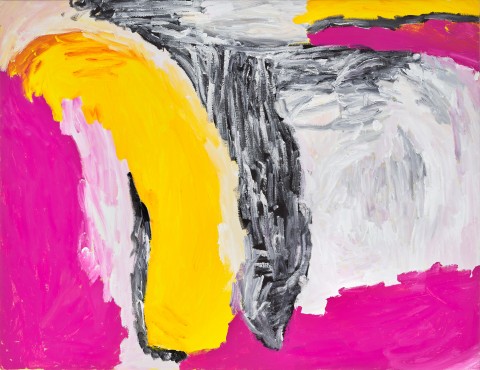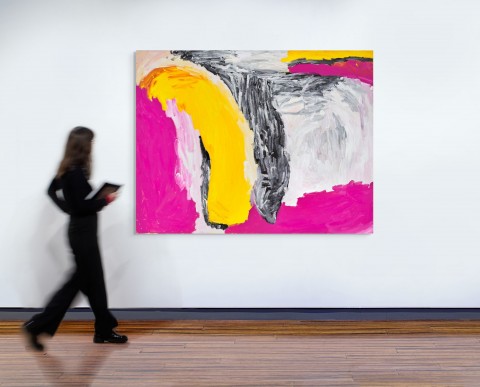NYINYILKI COUNTRY, 2010
MIRDIDINGKINGATHI JUWARNDA SALLY GABORI
synthetic polymer paint on linen
151.0 x 196.0 cm
bears inscription verso: artist’s name, title, medium, Mornington Island Arts and Crafts cat. 6195-L-SG-1010 and Alcaston Gallery cat. AK16558
Mornington Island Arts and Crafts, Mornington Island, Queensland (stamped verso)
Alcaston Gallery, Melbourne (stamped verso)
Private collection, Sydney, acquired from the above in 2023
This work is accompanied by a certificate of authenticity from Alcaston Gallery.
Only coming to painting in 2005 as an octogenarian, Kaiadilt elder Mirdidingkingathi Juwarnda Sally Gabori created with astounding innovation and intensity a series of paintings expressing cherished memories of living on the remote Bentinck Island, in the South Wellesley Island archipelago in the Gulf of Carpentaria. Although Gabori was an experienced barkstring weaver, Kaiadilt culture had no previous use of ochre painting in their ceremonial customs.1 Thus, the spontaneous apparition of Gabori’s bold artistic language, confidently and independently generated, quickly led to national and international renown. Shortly after she died in 2015, the Queensland Art Gallery | Gallery of Modern Art in Brisbane and the National Gallery of Victoria in Melbourne presented large retrospective exhibitions of her work, and in 2022, Gabori’s work was presented to much acclaim in a major solo exhibition overseas, at the Fondation Cartier pour l’art contemporain in Paris.
Nyinyilki Country, 2010, emphatically painted in saturated tones of magenta, yellow, black and white, is a monumental canvas of raw alla prima (wet-on-wet) gesture. Although her first paintings were of a small scale and densely patterned, from 2007 Gabori painted distinctive fields of colour and abstract topographical motifs into vast panoramic canvases. Although she derived her patterns of light and colouration from real-world topographical characteristics, the resulting works are almost entirely abstract, the motifs having been ‘transmuted so radically that the landscape which inspired them are barely recoverable.’2 Here the horizontal expanse is overlaid with semi-circular motifs of bold arches and sinuous outlines which echo the rocky outcrops and sandbars that form around Nyinyilki, an important area of gathering and fishing on the far eastern point of Bentinck Island. Gabori had played a vital role in maintaining the stone wall fish traps to catch barramundi at Nyinyilki, as well as harvesting freshwater from the billabong surrounded by Casuarina Trees with baler or trumpet shells, she also spoke of the maze-like trails left by dugongs after they had fed on the seagrass beds.3
In her younger years, Gabori had lived a traditional life amongst Kaiadilt people on the island until a series of catastrophic natural disasters in the late 1940s forced the remaining members of her population to relocate to the Presbyterian mission on Gununa, Mornington Island, mostly inhabited by local Lardil people.4 This relocation, as visitors on Lardil land, was thought to be temporary – only to become a decades-long exile with a devastating effect on Kaiadilt language and culture. In the Outstation Movement of the 1980s, Gabori and her husband Pat Gabori returned as often as possible to the sole re-established settlement on the island: Main Base, at Nyinyilki. Unfortunately, due to a lack of medical infrastructure and funding, the outstation was abandoned in the 2000s and the Kaiadilt people once again returned to Mornington Island.5
More than a tragic post-colonial artefact, Gabori’s joyous and idiosyncratic paintings, with shifting shafts of light, bold transitions of colour and incredible gestural strength, express an undiminished chain of deep cultural knowledge. With these unique paintings, Gabori asserts her claim as a dulmarra dangkaa, a traditional owner with unrestricted rights to live off the island’s bountiful natural resources.6
1. McLean, B., Mirdidingkingathi Juwarnda Sally Gabori: dulka warngiid: land of all, Queensland Art Gallery | Gallery of Modern Art, Brisbane, 2016, p. 17
2. Evans, N., and Johnson, P., ‘Bilda Miburiji Kurrij (seeing with far eyes). The Root of Kaiadilt Womens Art’, Art Bulletin of Victoria, National Gallery of Victoria, Melbourne, vol. 49, 2010, p. 62
3. Ryan, J., ‘Unprecedented: The Art of Sally Gabori’, in Sally Gabori : Mirdidingkingathi Juwarnda, Fondation Cartier, Paris, 2022, p. 89
4. ibid, p. 85. The Lardil already had known an earlier painting movement led by Goobalathaldin Dick Roughsey in the 1960s.
5. ibid, p. 243
6. Evans, op. cit., p.30
LUCIE REEVES-SMITH

